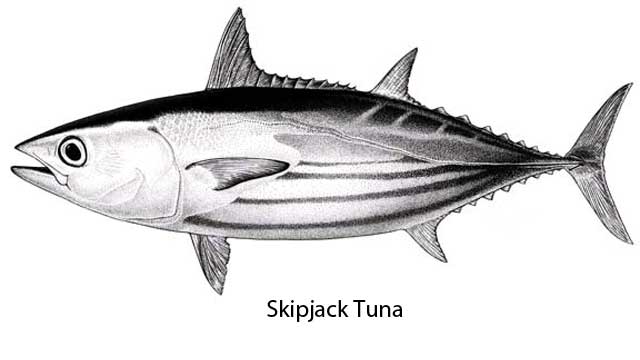
SKIPJACK

Katsuwonus pelamis
English:Skipjack Tuna, Skipjack, White Tuna, White Skipjack
Spanish: Bonito, Atun Blanco, Blanco Skipjack, Bonito del Sur, Cachurreta.
Like other tunas, the skipjack tuna has a fusiform body shape. It has two dorsal fins: the first with spines, the second without. Following the second dorsal fin are 7 to 9 finlets with separate rays useful in reducing turbulence and maintaining directional control when swimming at high speeds.
The body color above is dark blue or purple, while the belly and lower sides are silvery and have 4 to 6 dark but broken lines running the length of the body. These stripes along the belly distinguish this tuna from others of its type living in the same waters.
It is a streamlined, fast-swimming pelagic, common in tropical waters throughout the world, where it inhabits surface waters in large shoalss (up to 50,000 fish), feeding on fish, crustaceans,cephalopods and mollusks.. It is an important prey species for large pelagic fishes and sharks.
Skipjack occur in the entire tropical belt including both coasts of Mexico.
Skipjacks have a tendency to school, often under drifting objects or marine mammals. Skipjacks exhibit many types of schooling behavior, sometimes schooling with drifting objects, sharks, or whales.
The record maximum length is 43 inches (108 cm) fork length and the maximum weight is 76 pounds (34.5 kg). Skipjack tuna commonly grow to a length of 32 inches (80 cm), and a weight of 7-22 pounds (8 to 10 kg).